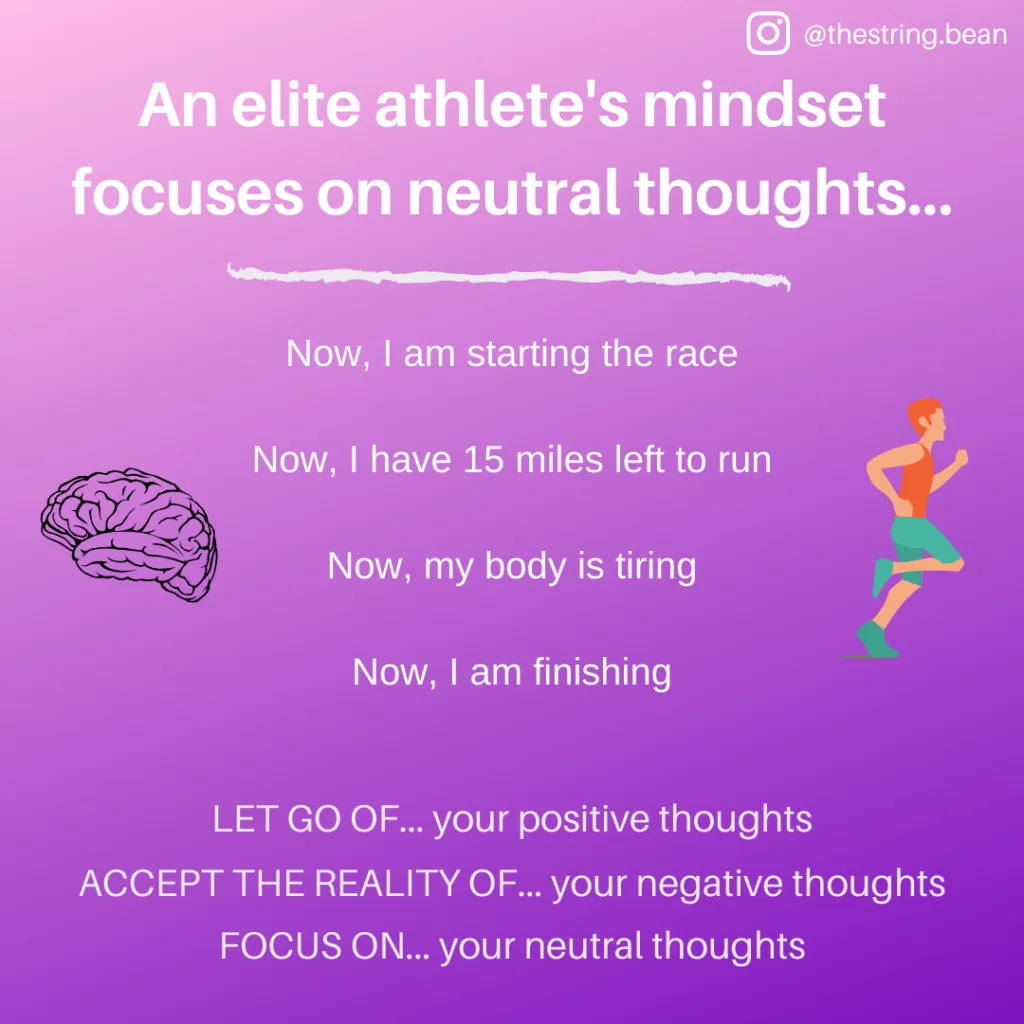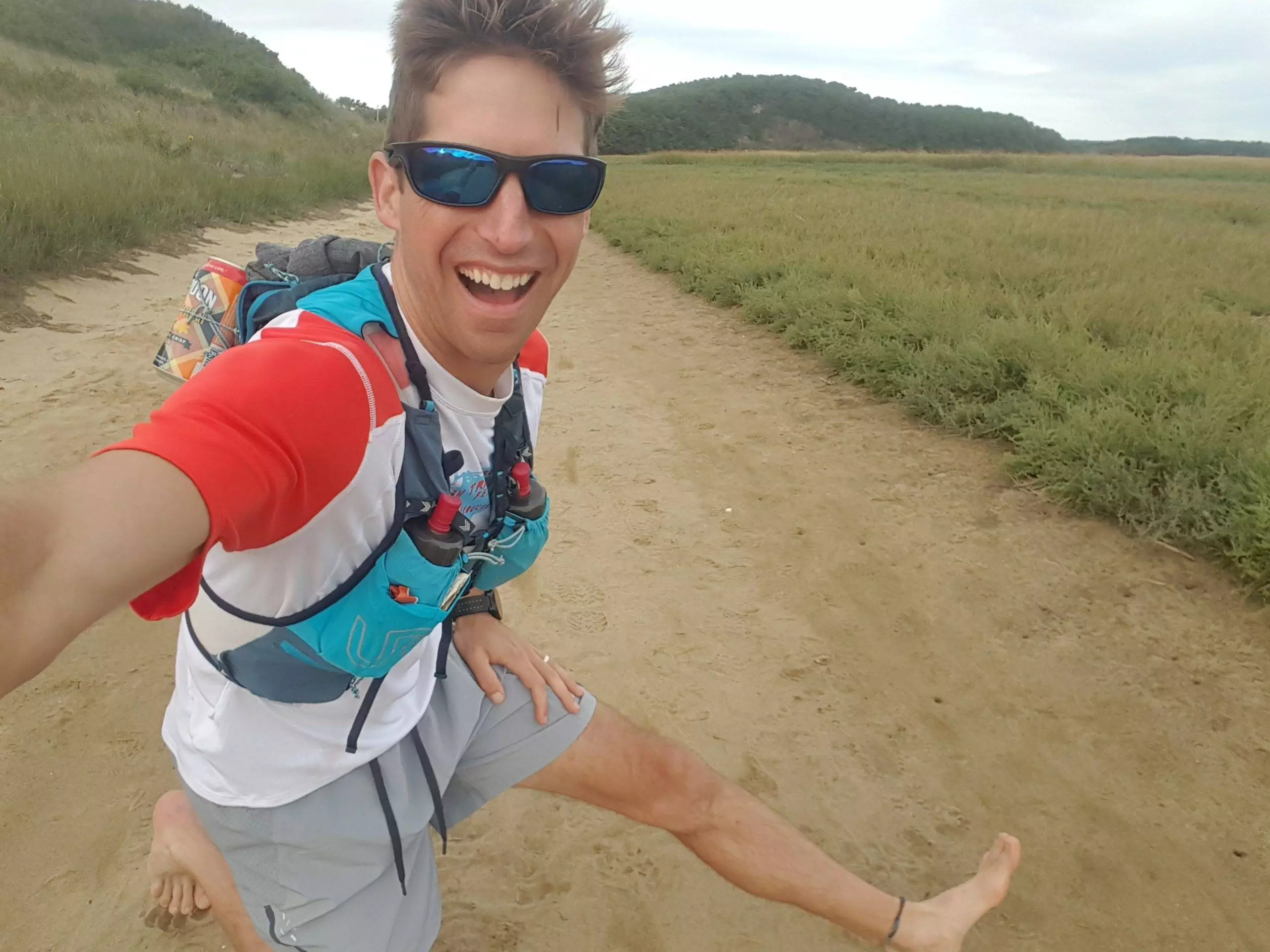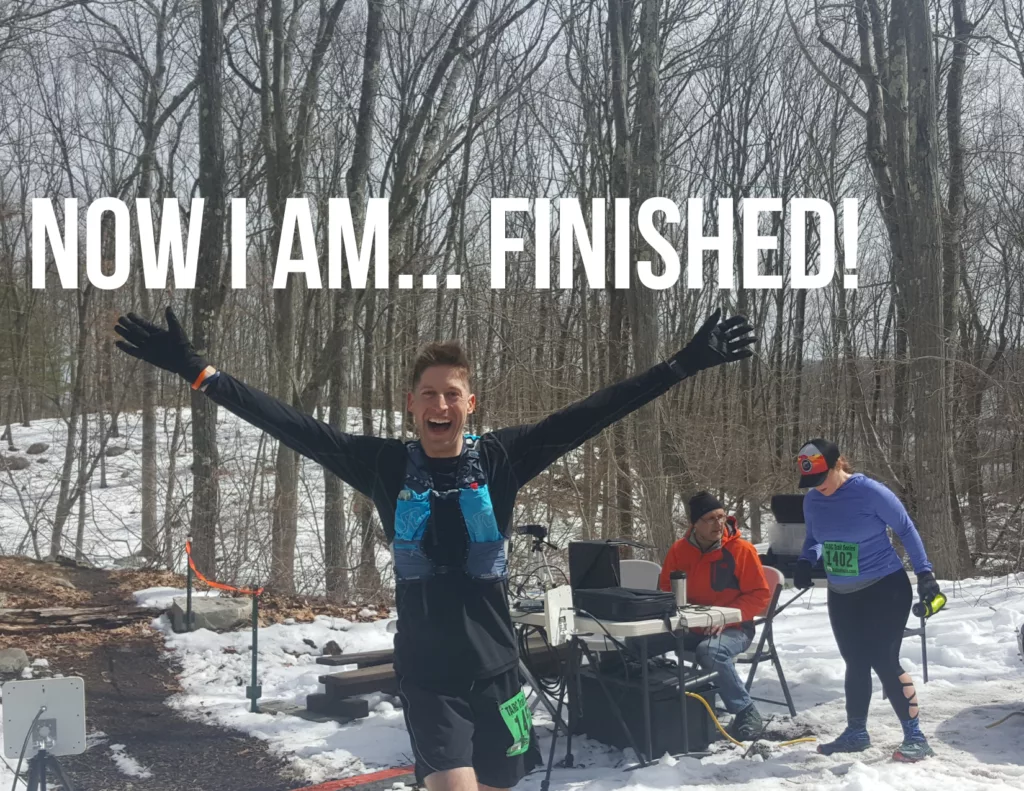Change is our fundamental experience.

The brain processes change.
As the environment and the body experience incessant change, the brain gets to work and processes about 11 million bits of data per second. 99% of this data each day is tuned out and the 1% that we are aware of is molded into approximately 6,200 conscious thoughts and perceptions that go through our minds during a full day ultra-marathon.
Good, Bad, and Neutral Thoughts
The brain categorizes our thoughts into three buckets: good, bad, and neutral. The three types of thoughts are not difficult to understand, and we experience:
Good thoughts
- “I couldn’t have chosen a better pre-race meal. That five cheese omelet and chocolate milkshake is giving me great energy right now!”
- “I’m in first place after 50 miles. 50 more to go and I’ve got this thing won! Let’s GOOOO!”
Bad thoughts
- “I’ll never make it, my fuel plan sucks (why did I eat that omelet).”
- “Shoot, is that a hot spot forming? What if it turns gangrene and I lose the whole foot??”
Neutral thoughts
- “My pace is 8:04 minutes per mile.”
- “The temperature is decreasing.”
Neutral thoughts are the most tricky. On the surface, they are simply the uninteresting bits of our present data.
We Screw Everything Up
So far, everything in our mindset system has worked properly. It is what we typically do with next these categories that leads us into trouble.
We love to hold onto good thoughts as if we will never have them again. We work to freeze time and not let a good thought escape. This mental habit in the mindfulness literature is called “grasping”.
We actively push away bad thoughts and try to run from them. We work to throw them away or convince ourselves that they are actually good. This is called “rejecting”.
In our constant action to pursue pleasure by grasping onto our good thoughts and avoid pain by rejecting our bad thoughts, we pay little attention to our neutral thoughts. Neutral thoughts get no respect. What we do to our neutral thoughts is called “ignoring”.
Overall, our good and bad thoughts tend to be derived from emotion and send our train of thought chugging back and forth between the past and the future. Our neutral thoughts tend to be derived from immediate actions and conditions in the present moment.

We have to let go of the good while change is occurring.
The problem with grasping at good thoughts is that while we are holding them tighter than a hungry baby holds their bottle, the body and the environment are ever changing. If we don’t let go of our good thoughts, we are very likely to miss an important new stimuli that comes up in a neutral thought.
We have to accept the bad while change is occurring.
The problem with rejecting bad thoughts is that they are our most important teacher. Pain, anger, frustration, fear, and hunger are all mentors. When we reject our bad thoughts, we miss a golden opportunity learn what a new stimuli in our changing environment and body is trying to teach us. It is our bad thoughts that push us to change with change. Mine through the bad thoughts and explore what the lesson is.
An elite athlete’s mindset focuses on the neutral.
Our neutral thoughts hold the most power in our performance. Think of the neutral thoughts as a focus on the change itself. While good and bad thoughts are typically attached to an emotion conjured up from holding onto the past or looking deep into the future, neutral thoughts are attached to our present action or condition. They are the calculated facts of what is occurring in the present moment. As the conditions around us change and as our present actions change, a focus on these changes is the key to a strong, calculated, and effective mindset.
“Now I Am” Statements
This is a great tool for getting focused on our present actions and conditions. Just think or speak the three words, “now I am [ ]”, and fill in the blank.
Now I am running at a 5:34 pace…
Now I am slowing down…
Now I am climbing…
Now I am breaking a hard sweat…
Now I am feeling thirsty…
Now I am feeling a pain in my toe…
Now I am seeing the sun setting…
Now I am noticing the temperature dropping…
Now it is cold…
If we keep our concentration on our present actions and conditions by keeping our thoughts on “now I am” and neutral, then we reduce emotion and allow our mind to work in harmony with our body. A neutral mindset becomes more of a computer and less of a magic eight ball. A neutral mindset is the voice that says, “get your s*** together and focus on THIS one singularly step!”. The “now I am” mindset lets go of the good, but useless thought, extracts the important data from the bad thought, and makes consistent, necessary changes that keep up with change.
My real world experience.
I was competing in a 100 mile ultramarathon in Maine a few years back. My training was impeccable, I had already completed a 100 mile ultra in the past, and I felt very confident.
For the first 50 miles, all I kept thinking about was how well training went and how fit I was. I squeezed my good thoughts so tightly that they were gasping for air. My good thoughts forced me to race more aggressively than I should have. I wasn’t calculating the changes in terrain or how much I was sweating. I pushed aside the bad thoughts revolving around the hot spots on my big toes and even went so far as to reframe my pain to feel empowered: “all strong runners deal with pain so I can deal with it too!” All my thoughts culminated to how good it will feel to be on the podium – future emotions.
At the midway home base check in, my good and bad thoughts kept me from calculating the changing temps, my calorie deficit, and the hot spots on my big toes. I didn’t pack enough clothes, eat enough food, or tend to my feet. I pushed to get out of the aid station as fast as possible. At mile 65 my wheels fell off. Uncontrollable shivering was met with shooting pain in my toes with every step. At mile 75 I got back to my support car. Again, my thoughts stayed rooted in emotional goods and bads. “Am I doing permanent damage? I think I am hypothermic. But what a heroic effort I put forth and I was winning at some point! How many people are ahead of me now? Shoot, I can’t win. I am an utter failure. What will others think of me?”
I didn’t take time to be neutral and calculating. I had 12 hours left to finish the final 25 miles. I could have slept in the warm car for 4 hours and walked much of the final 25 miles to still finish. Instead, my good and bad thoughts were throwing a full on pity party with every A-list emotion making an appearance. I ended up never taking another step in that race and earned my first DNF. I didn’t run again for many months after that race as I worked to find my passion once again.

The Chinese Farmer and his Horse.
There is a well-told parable derived from Lao Tzu about a Chinese Farmer and his Horse. Of the many versions of the story that exist, here is one:
There was a Farmer who had a grand Horse that was the backbone of the farm’s function. One day the horse escaped. All the town’s people ran to the Farmer and exclaimed, “We heard about your Horse escaping. That is such bad news!” The Farmer simply replied, “We’ll see.”
The next day the Horse returned, but brought with it six wild horses. All the town’s people ran to the Farmer and exclaimed, “We heard you now own many horses for your farm. That is such good news!” The Farmer simply replied, “We’ll see.”
The following day the Farmer’s Daughter was working to tame one of the wild horses when it kicked her and shattered her leg. All the town’s people ran to the Farmer and exclaimed, “We heard what happened to your daughter’s leg. That is such bad news!” The Farmer simply replied, “We’ll see.”
The day after that, the nation went to war and the military came through the town to seize young women and men to fight on the front lines. They took one look at the farmer’s daughter’s leg and said she could stay home. All the town’s people ran to the Farmer and exclaimed, “We heard your daughter was spared from war. That is such good news!” The Farmer simply replied, “We’ll see.”
No moment is “good” or “bad”.
Every moment is simply a rung in the ladder that gets us to the next moment. Ultimately, the most effective athlete mindset is the one that is concentrating on the present moment with a focus on our neutral, calculating, and un-emotional thoughts. We have no idea how one moment is supposed to lead to the next one so let go of the good, explore the bad, and never let any thought overpower your awareness of your present actions and conditions.
Evren Gunduz has been a competitive runner since 2014 and has been coached by Joe McConaughy since 2017. With a passion for trails and a strange love for pain, he has completed ten ultra distance events ranging from 50 kilometers to a 100 miler. He is the founder and CEO of ELE Inc. Evolution Performance Systems (enjoylifeeducation.org) in which he trains competitive high school and college athletic teams to strengthen their mindset, become empowering leaders, and develop a high achieving culture. He lives in Cambridge, MA with his wife Tara who is a high school math teacher and certified yoga and mindfulness instructor. Together they ski, hike, run and get to coach a high performing varsity girls soccer team. Evren draws much inspiration from these skilled, driven, and mentally strong student-athletes.







YES TO THIS! This is such a timely read and so important to remember that nothing is good or bad but just is. I’ve always struggled with this especially as it relates to my running. Thank you for the reminder/inspiration!
Great article….the entire time I was reading this I was thinking, “This guy must be into mindfulness/ meditation, or Buddhism in some way” then I read the bio and got confirmation! I’ve always loved that horse parable. Thanks for sharing.
Great post! I think this mentality transcends sports and can be applied in our everyday lives as well. Thank you!
Thanks Charley! Yes, a friend of mine who is really into golfing was talking about how they have the same focus. You know, golfing = ultrarunning, right?
Ev- enjoyed the article. Your perspective from being a participant with examples of real time perceptions brought the article to life for me. “Mental toughness” may sound ethereal to some. However its very real how you can see this desirable trait in someone that is applying it. Thanks for sharing your experiences and giving us a glimpse into your thought processes.
WOW!!!!!
INSPIRATIONAL
INFORMATIVE
HONEST
Thanks for sharing
WOW
INSPIRATIONAL
INFORMATIVE
HONEST
I have that Pinelands shirt!